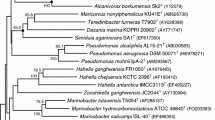Abstract
Marine bacterial isolates Vibrio sp. HC0601C5 and Halomonas meridiana str. HC4321C1 were isolated off the coast of southern California and were found to produce an expanded suite of previously identified amphiphilic siderophores. Specifically two new members of the amphibactin family, amphibactins S and T, which have a C14:1 ω-7 fatty acid and a saturated C12 fatty acid, respectively, were produced by Vibrio sp. HC0601C5. These siderophores are produced in addition to a number of previously described amphibactins and are excreted into the culture supernatant. Two new members of the aquachelin family of siderophores, aquachelins I and J, which have an hydroxylated C12 fatty acid and a saturated C10 fatty acid, respectively, were produced by Halomonas meridiana str. HC4321C1. These four new siderophores are more hydrophilic than their previously reported relatives, aquachelins A–D and the amphibactin suite of siderophores.







Similar content being viewed by others
References
Anisimova M, Gascuel O (2006) Approximate likelihood ratio test for branches: a fast, accurate and powerful alternative. Syst Biol 55(4):539–552
Castresana J (2000) Selection of conserved blocks from multiple alignments for their use in phylogenetic analysis. Mol Biol Evol 17(4):540–552
Chevenet F, Brun C, Banuls AL, Jacq B, Chisten R (2006) TreeDyn: towards dynamic graphics and annotations for analyses of trees. BMC Bioinformatics 7:439
Dereeper A, Guignon V, Blanc G, Audic S, Buffet S, Chevenet F, Dufayard JF, Guindon S, Lefort V, Lescot M, Claverie JM, Gascuel O (2008) Phylogeny.fr: robust phylogenetic analysis for the non-specialist. Nucleic Acids Res 1:36 (Web Server issue):W465-9. Epub 19 Apr 2008
Edgar RC (2004) MUSCLE: multiple sequence alignment with high accuracy and high throughput. Nucleic Acids Res 32(5):1792–1797
Gledhill M, Van den Berg CMG (1994) Determination of complexation of iron(III) with natural organic complexing ligands in seawater using cathodic strip** voltammetry. Marine Chem 47:41–54
Gledhill M, McCormack P, Ussher S, Achterberg EP, Mantoura RFC, Worsfold PJ (2004) Production of siderophore type chelates by mixed bacterioplankton populations in nutrient enriched seawater incubations. Marine Chem 88:75–83
Guindon S, Gascuel O (2003) A simple, fast, and accurate algorithm to estimate large phylogenies by maximum likelihood. Syst Biol 52(5):696–704
Homann VV, Sandy M, Tincu JA, Templeton AS, Tebo BM, Butler A (2009) Loihechelins A-F, a suite of amphiphilic siderophores produced by the marine bacterium Halomonas LOB-5. J Natl Prod 72:884–888
Huijberts GNM, de Rijk TC, de Waard P, Eggink G (1994) 13C nuclear magnetic resonance studies of Pseudomonas putida fatty acid metabolic routes involved in poly(3-hydroxyalkanoate) synthesis. J Bacteriol 176:1661–1666
Huson DH, Richter DC, Rausch C, Dezulian T, Franz M, Rupp R (2007) Dendroscope: an interactive viewer for large phylogenetic trees. BMC Bioinformatics 8(1):460
Ito Y, Butler A (2005) Structure of synechobactins, new siderophores of the marine cyanobacterium Synechococcus sp. PCC 7002. Limnol Oceanogr 50:1918–1923
Lewis BL, Holt PD, Taylor SW, Wilhelm SW, Trick CG et al (1995) Voltammetric estimation of iron(III) thermodynamic stability constants for catecholate siderophores isolated from marine bacteria and cyanobacteria. Marine Chem 50:179–188
Macrellis HM, Trick CG, Rue EL, Smith G, Bruland KW (2001) Collection and detection of natural iron-binding ligands from seawater. Marine Chem 76:175–187
Martin JD, Ito Y, Homann VV, Haygood MG, Butler A (2006) Structure and membrane affinity of new amphiphilic siderophores produced by Ochrobactrum sp. SP18. J Biol Inorg Chem 11:633–641
Martinez JS, Zhang GP, Holt PD, Jung HT, Carrano CJ et al (2000) Self-assembling amphiphilic siderophores from marine bacteria. Science 287:1245–1247
Martinez JS, Carter-Franklin JN, Mann EL, Martin JD, Haygood MG, Butler A (2003) Structure and membrane affinity of a suite of amphiphilic siderophores produced by a marine bacterium. Proc Natl Acad Sci USA 100:3754–3759
Mawji E, Gledhill M, Milto JA, Tarran GA, Ussher S, Thompson A, Wolff GA, Worsfold PJ, Achterberg EP (2008) Hydroxamate siderophores: occurrence and importance in the Atlantic Ocean. Environ Sci Technol 42:8675–8680
Roepstorff P, Fohlman J (1984) Proposal for a common nomenclature for sequence ions in mass spectra of peptides. Biomed Mass Spectrom 11(11):601
Rue EL, Bruland KW (1995) Complexation of iron(III) by natural ligands in the Central North Pacific as determined by a new competitive ligand equilibration/adsorptive cathodic strip** voltammetric method. Marine Chem 50:117–138
Sandy M, Butler A (2009) Microbial iron acquisition: marine and terrestrial siderophores. Chem Rev 109:4580–4595
Schwyn B, Neilands JB (1987) Universal chemical assay for the detection and determination of siderophores. Anal Biochem 160:47–56
Vraspir JM, Butler A (2009) Chemistry of marine ligands and siderophores. Ann Rev Marine Sci 1:43–63
Wu J, Luther GW (1995) Complexation of Fe(III) by natural organic ligands in the Northwest Atlantic Ocean by a competitive ligand method and a kinetic approach. Marine Chem 50:159–177
Acknowledgments
We thank the officers, crew, and scientific party aboard the R/V Atlantis during SEEPS ‘07 for their assistance and Craig A. Carlson and Craig E. Nelson for helpful discussions and technical support for 16S rDNA amplification and phylogenetic analysis. A.B. gratefully acknowledges NIH GM38130. J.M.V. is supported by a National Science Foundation Graduate Research Fellowship. Any opinions, findings, conclusions or recommendations expressed in this publication are those of the author(s) and do not necessarily reflect the views of the National Science Foundation.
Author information
Authors and Affiliations
Corresponding author
Rights and permissions
About this article
Cite this article
Vraspir, J.M., Holt, P.D. & Butler, A. Identification of new members within suites of amphiphilic marine siderophores. Biometals 24, 85–92 (2011). https://doi.org/10.1007/s10534-010-9378-1
Received:
Accepted:
Published:
Issue Date:
DOI: https://doi.org/10.1007/s10534-010-9378-1




